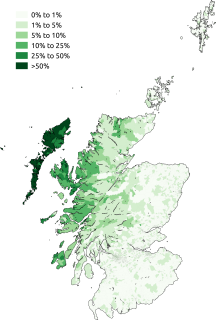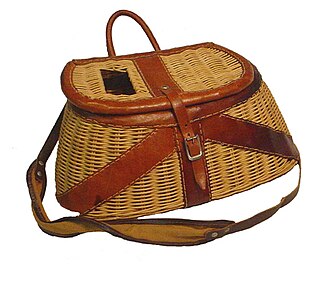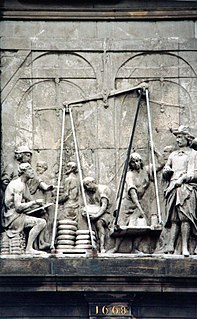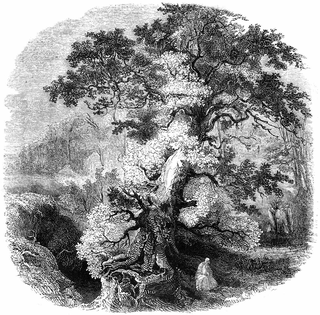Related Research Articles

A crannog is typically a partially or entirely artificial island, usually built in lakes and estuarine waters of Scotland, Wales, and Ireland. Unlike the prehistoric pile dwellings around the Alps, which were built on the shores and not inundated until later, crannogs were built in the water, thus forming artificial islands.

The inch is a unit of length in the (British) imperial and United States customary systems of measurement. It is equal to 1⁄36 yard or 1⁄12 of a foot. Derived from the Roman uncia ("twelfth"), the word inch is also sometimes used to translate similar units in other measurement systems, usually understood as deriving from the width of the human thumb.

Scottish Gaelic is a Goidelic language native to the Gaels of Scotland. As a Goidelic language, Scottish Gaelic, as well as both Irish and Manx, developed out of Old Irish. It became a distinct spoken language sometime in the 13th century in the Middle Irish period, although a common literary language was shared by Gaels in both Ireland and Scotland down to the 16th century. Most of modern Scotland was once Gaelic-speaking, as evidenced especially by Gaelic-language place names.

Lochboisdale is the main village and port on the island of South Uist, Outer Hebrides, Scotland. Lochboisdale is within the parish of South Uist, and is situated on the shore of Loch Baghasdail at the southern end of the A865.

A creel is a wicker basket usually used for carrying fish or blocks of peat. It is also the cage used to catch lobsters and other crustaceans.
The long hundred, also known as the great hundred or twelfty, is the number that was referred to as "hundred" in Germanic languages prior to the 15th century, which is now known as 120, one hundred and twenty, or six score. The number was simply described as hundred and translated into Latin in Germanic-speaking countries as centum, but the qualifier "long" is now added because present English uses the word "hundred" exclusively to refer to the number of five score (100) instead.

An ell is a northwestern European unit of measurement, originally understood as a cubit. The word literally means "arm", and survives in form of the modern English word "elbow" (arm-bend). Later usage through the 19th century refers to several longer units, some of which are thought to derive from a "double ell".
A bidding stick is a term for a wooden object, such as a club or baton, carried by a messenger and used by Northern Europeans, for example in Scotland and Scandinavia, to rally people for things (assemblies) and for defence or rebellion.

Canadian Gaelic or Cape Breton Gaelic, known in English as often simply Gaelic, is a collective term for the dialects of Scottish Gaelic spoken in Atlantic Canada.

The Dutch units of measurement used today are those of the metric system. Before the 19th century, a wide variety of different weights and measures were used by the various Dutch towns and provinces. Despite the country's small size, there was a lack of uniformity. During the Dutch Golden Age, these weights and measures accompanied the Dutch to the farthest corners of their colonial empire, including South Africa, New Amsterdam and the Dutch East Indies. Units of weight included the pond, ons and last. There was also an apothecaries' system of weights. The mijl and roede were measurements of distance. Smaller distances were measured in units based on parts of the body – the el, the voet, the palm and the duim. Area was measured by the morgen, hont, roede and voet. Units of volume included the okshoofd, aam, anker, stoop, and mingel. At the start of the 19th century the Dutch adopted a unified metric system, but it was based on a modified version of the metric system, different from the system used today. In 1869, this was realigned with the international metric system. These old units of measurement have disappeared, but they remain a colourful legacy of the Netherlands' maritime and commercial importance and survive today in a number of Dutch sayings and expressions.
The davoch, davach or daugh is an ancient Scottish land measurement. All of these terms are cognate with modern Scottish Gaelic dabhach. The word dabh or damh means an "ox", but dabhach can also refer to a "tub", so may indicate productivity. It was called the arachor in the Lennox.
An ounceland is a traditional Scottish land measurement. It was found in the West Highlands, and Hebrides. In Eastern Scotland, other measuring systems were used instead. It was equivalent to 20 pennylands or one eighth of a markland. Like those measurements, it is based on the rent paid, rather than the actual land area. It was also known as a "tirung", or a dabhach, which is a term of Pictish origin, also used in the east of Scotland too, but for a different measurement. The “ounceland” is thought to be of Norse origin, so it is possible that Norse (‘ounceland’) and native systems (dabhach) were conflated in the west.

Gaelic warfare was the type of warfare practised by the Gaelic peoples, that is the Irish, Scottish, and Manx, in the pre-modern period.

Reaper is a restored historic Fifie herring drifter which is registered by the National Historic Ships Committee as part of the National Historic Fleet of the UK, and currently operates as a museum ship.
Cran may refer to:

Isle Martin is an uninhabited island in Loch Broom, on the west coast of Scotland. It is the closest of the Summer Isles to Ullapool and has been the site of a monastery, a herring curing station and a flour mill. Now recognised as a bird sanctuary, it is owned and managed by a community trust.

Gaelic medium education is a form of education in Scotland that allows pupils to be taught primarily through the medium of Scottish Gaelic, with English being taught as the secondary language.

The Lamont Harp, or Clàrsach Lumanach is a Scottish Clarsach currently displayed in the National Museum of Scotland. It is believed to date back to the 15th century, and to have originated in Argyll. Along with the Queen Mary Harp and the Trinity College harp, it is one of the only three surviving medieval Gaelic harps.

Many types of trees found in the Celtic nations are considered to be sacred, whether as symbols, or due to medicinal properties, or because they are seen as the abode of particular nature spirits. Historically and in folklore, the respect given to trees varies in different parts of the Celtic world. On the Isle of Man, the phrase 'fairy tree' often refers to the elder tree. The medieval Welsh poem Cad Goddeu is believed to contain Celtic tree lore, possibly relating to the crann ogham, the branch of the ogham alphabet where tree names are used as mnemonic devices.
References
- ↑ "cran". sizes.com.
- ↑ Cardarelli, François - Encyclopedia of Scientific Units, Weights & Measures (Springer .2003 ISBN 1-85233-682-X)
- ↑ "Cran". Merriam-Webster Dictionary . "Scottish Gaelic crann tree, lot, measure of herring; akin to Old Irish crann tree".